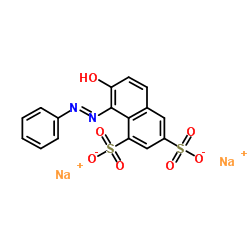Analysis of sonolytic degradation products of azo dye Orange G using liquid chromatography-diode array detection-mass spectrometry.
Meiqiang Cai, Micong Jin, Linda K Weavers, Meiqiang Cai, Micong Jin, Linda K. Weavers
文献索引:Ultrason. Sonochem. 18(5) , 1068-76, (2011)
全文:HTML全文
摘要
In this paper, seven new sonolytic degradation products of Orange G were found and identified using powerful analytical techniques such as liquid chromatography-electrospray ionization mass spectrometry (LC-ESI-MS), tandem mass spectrometry (MS/MS), and liquid chromatography with diode-array detection (LC-DAD). Each technique provided complementary information for the degradation products identification. In order to resolve the MS and MS/MS spectra obtained, the separation conditions were optimized. Among them, Orange G was unambiguously identified based on its abundant [M-H](-) ion, [M+H](+) ion, ultra-violet and visible spectra, retention time, and tandem mass spectrometric analysis compared with an authentic standard. The seven new degradation products were tentatively identified based on ultra-violet and visible spectra, [M-H](-) ions, and tandem mass spectrometry. The neutral losses of SO(2), SO(3), N(2) and H(2)O for MS/MS spectra which appear to be characteristic of the negative ion mode were observed. Based on this by-product identification, a possible multi-step degradation scheme is proposed. The analysis results of degradation products reveal that the degradation mechanism proceeds via reductive cleavage of the azo linkage, as well as intermolecular dehydration and desulfonation due to the powerful oxidizing hydroxyl radicals as well as hydrogen radical.Copyright © 2011 Elsevier B.V. All rights reserved.
相关化合物
| 结构式 | 名称/CAS号 | 分子式 | 全部文献 |
|---|---|---|---|
 |
酸性橙 10
CAS:1936-15-8 |
C16H10N2Na2O7S2 |
|
Development of a method for the analysis of seven banned azo...
2009-04-15 [Talanta 78(1) , 178-86, (2009)] |
|
Hydrogen peroxide primes heart regeneration with a derepress...
2014-09-01 [Cell Res. 24(9) , 1091-107, (2014)] |
|
Ethylenediamine modified starch as biosorbent for acid dyes.
2009-12-30 [J. Hazard. Mater. 172(2-3) , 1665-70, (2009)] |
|
Purification and characterization of a novel laccase from Co...
2013-02-01 [Mol. Biol. Rep. 40(2) , 1487-94, (2013)] |
|
Novel amphiphilic polymeric ionic liquid-solid phase micro-e...
2014-07-04 [J. Chromatogr. A. 1349 , 24-9, (2014)] |